2014 MERCEDES-BENZ SLS AMG COUPE traction control
[x] Cancel search: traction controlPage 6 of 292

1, 2, 3 ...
12 V socket see Sockets
4ETS (Electronic Traction System) ....55 A
ABS (Anti-lock Braking System) Display message ............................ 165
Function/notes ................................ 54
Warning lamp ................................. 192
Activating/deactivating cooling
with air dehumidification .................108
ADAPTIVE BRAKE ................................. 58
Additional speedometer ...................158
Additives (engine oil) ........................282
Adjusting lumbar support ..................86
Air bags Display message ............................ 171
Front air bag (driver, front
passenger) ....................................... 40
Head bag ......................................... 42
Important safety notes ....................38
Knee bag .......................................... 41
PASSENGER AIR BAG OFF
indicator lamp .................................. 42
Safety guidelines ............................. 37
Side impact air bag ..........................41
Air-conditioning system
see Climate control
Air filter (display message) ..............180
AIRSCARF Switching on/off .............................. 88
AIRSCARF vents
Setting the blower output ..............114
Air vents
Important safety notes ..................113
Setting ........................................... 113
Setting the blower output of the
AIRSCARF vents ............................ .114
Setting the center air vents ...........114
Setting the side air vents ...............114
Switching AIRSCARF on/off ............88
Alarm system
see ATA (Anti-Theft Alarm system) AMG
Adaptive sport suspension system 140
Button for AMG menu ....................128
E-SELECT leve r.............................. 121
Menu (on-board computer) ............161
SETUP ............................................ 128
SPEEDSHIFT DCT 7-gear sport
transmission .................................. 121
Anti-lock braking system
see ABS (Anti-lock Braking System)
Anti-theft alarm system
see ATA (Anti-Theft Alarm system)
Ashtray ............................................... 203
ASSYST PLUS service interval
display
Hiding service messages ...............222
Service messages ..........................222
ATA (Anti-Theft Alarm system)
Activating/deactivating ...................58
Function .......................................... .58
Switching off the alarm ....................58
Audio menu (on-board computer) ....154
Audio system see separate operating instructions
Authorized Centers
see Qualified specialist workshop
Authorized Mercedes-Benz Center
see Qualified specialist workshop
Authorized workshops
see Qualified specialist workshop
AUTO lights
Display message ............................ 174
Automatic headlamp mode ................96 B
BAS (Brake Assist System) .................55
Battery Display message ............................ 185
Battery (SmartKey)
Checking .......................................... 65
Important safety notes ....................64
Replacing ......................................... 65
Battery (vehicle)
Charging ........................................ 239
Display message ............................ 178
Important safety notes ..................236
Jump starting ................................. 2404
Index
Page 9 of 292
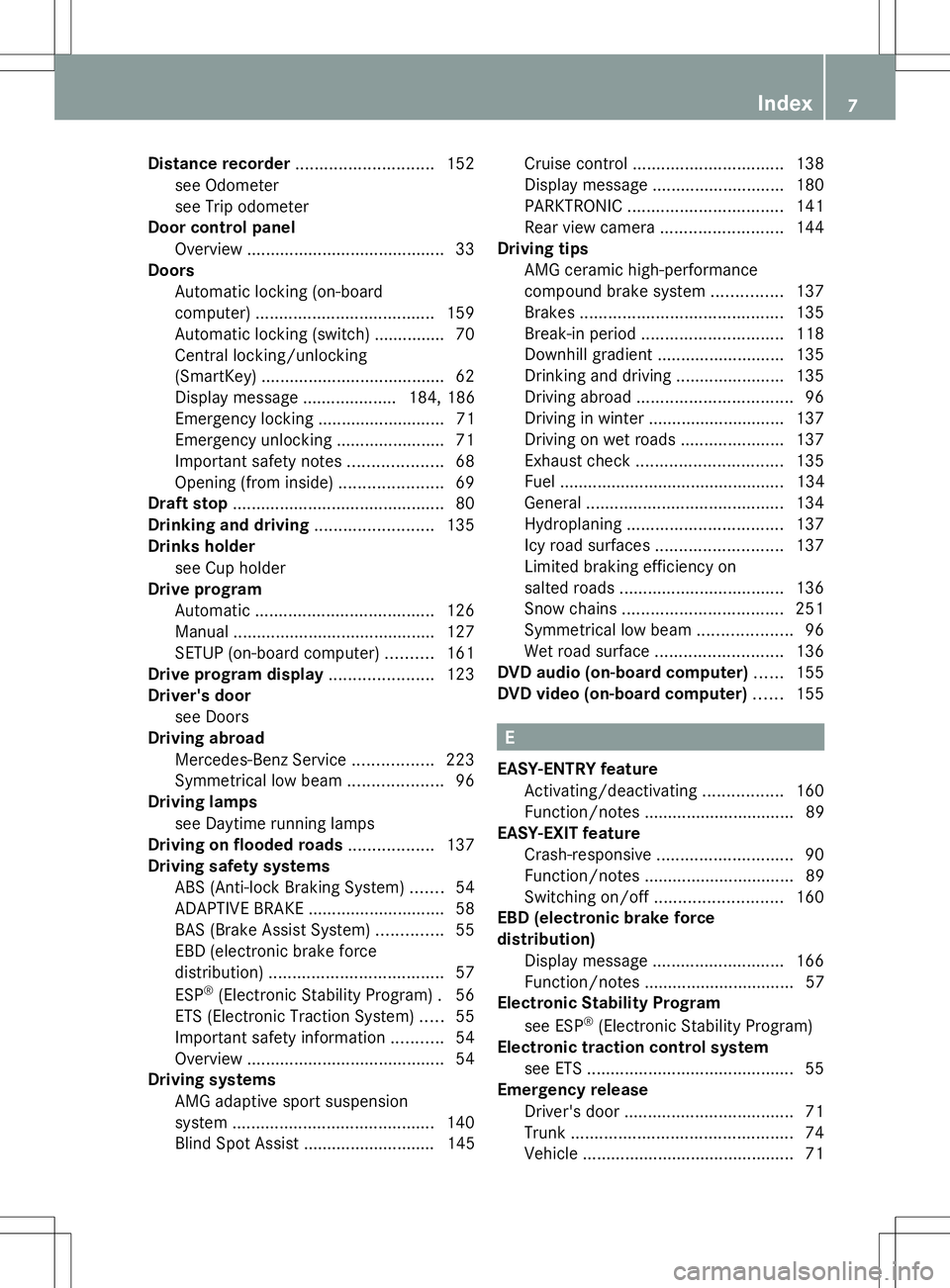
Distance recorder
............................. 152
see Odometer
see Trip odometer
Door control panel
Overview .......................................... 33
Doors
Automatic locking (on-board
computer) ...................................... 159
Automatic locking (switch) .............. .70
Central locking/unlocking
(SmartKey) ...................................... .62
Display message .................... 184, 186
Emergency locking ........................... 71
Emergency unlocking .......................71
Important safety notes ....................68
Opening (from inside) ......................69
Draft stop ............................................. 80
Drinking and driving .........................135
Drinks holder see Cup holder
Drive program
Automatic ...................................... 126
Manual .......................................... .127
SETUP (on-board computer) ..........161
Drive program display ......................123
Driver's door see Doors
Driving abroad
Mercedes-Benz Service .................223
Symmetrical low bea m.................... 96
Driving lamps
see Daytime running lamps
Driving on flooded roads ..................137
Driving safety systems ABS (Anti-lock Braking System) .......54
ADAPTIVE BRAKE ............................. 58
BAS (Brake Assist System) ..............55
EBD (electronic brake force
distribution) ..................................... 57
ESP ®
(Electronic Stability Program) .56
ETS (Electronic Traction System) .....55
Important safety information ...........54
Overview .......................................... 54
Driving systems
AMG adaptive sport suspension
system ........................................... 140
Blind Spot Assist ............................ 145 Cruise control
................................ 138
Display message ............................ 180
PARKTRONIC ................................. 141
Rear view camera .......................... 144
Driving tips
AMG ceramic high-performance
compound brake system ...............137
Brakes ........................................... 135
Break-in period .............................. 118
Downhill gradient ........................... 135
Drinking and driving .......................135
Driving abroad ................................. 96
Driving in winter ............................ .137
Driving on wet roads ......................137
Exhaust check ............................... 135
Fuel ................................................ 134
General .......................................... 134
Hydroplaning ................................. 137
Icy road surfaces ........................... 137
Limited braking efficiency on
salted road s................................... 136
Snow chains .................................. 251
Symmetrical low bea m.................... 96
Wet road surface ........................... 136
DVD audio (on-board computer) ......155
DVD video (on-board computer) ......155 E
EASY-ENTRY feature Activating/deactivating .................160
Function/notes ................................ 89
EASY-EXIT feature
Crash-responsive ............................. 90
Function/notes ................................ 89
Switching on/off ........................... 160
EBD (electronic brake force
distribution)
Display message ............................ 166
Function/notes ................................ 57
Electronic Stability Program
see ESP ®
(Electronic Stability Program)
Electronic traction control system
see ETS ............................................ 55
Emergency release
Driver's door .................................... 71
Trunk ............................................... 74
Vehicle ............................................. 71 Index
7
Page 57 of 292
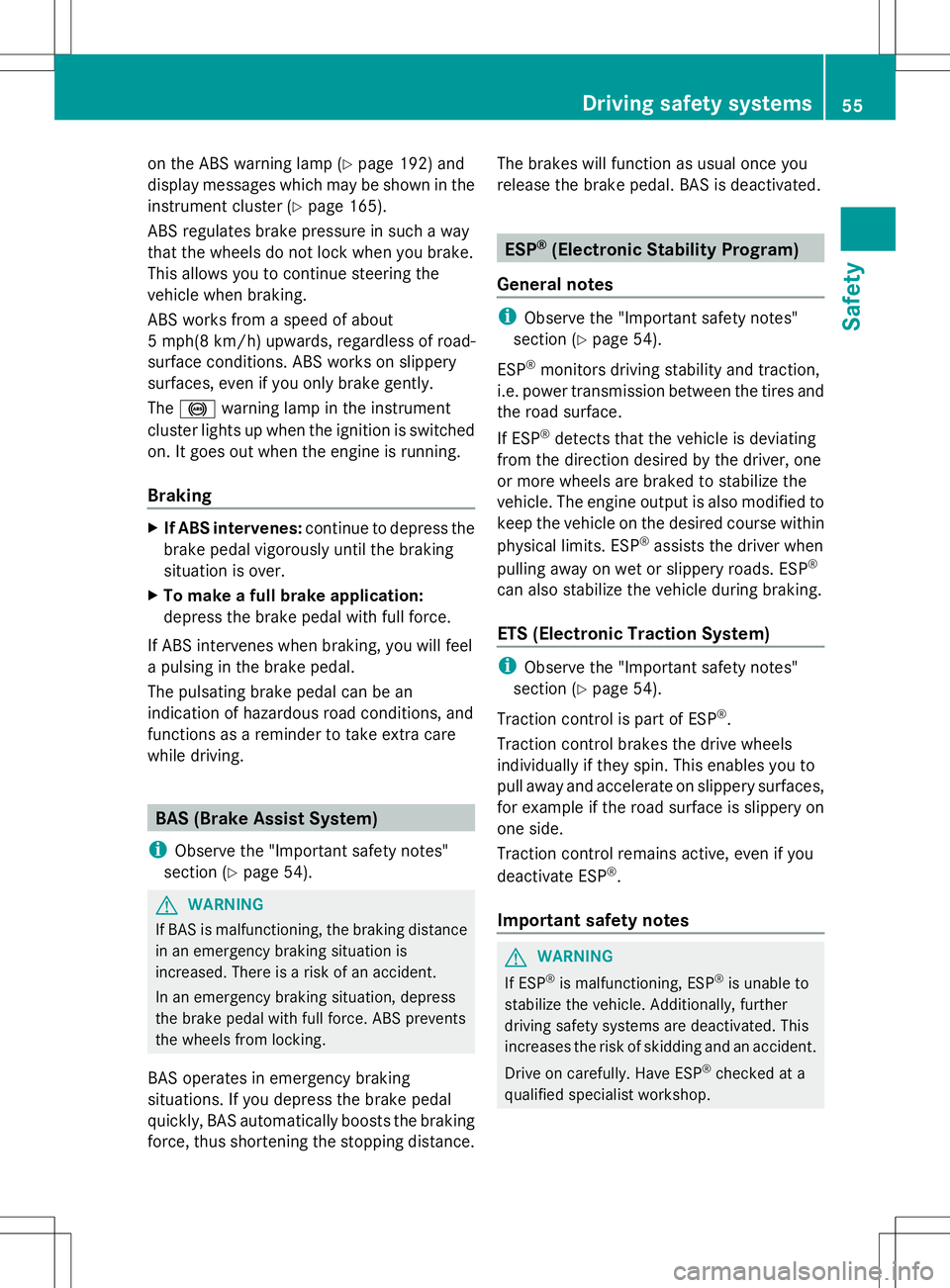
on the ABS warning lamp (Y
page 192) and
display messages which may be shown in the
instrument cluster (Y page 165).
ABS regulates brake pressure in such a way
that the wheels do not lock when you brake.
This allows you to continue steering the
vehicle when braking.
ABS works from a speed of about
5 mph(8 km/h) upwards, regardless of road-
surface conditions. ABS works on slippery
surfaces, even if you only brake gently.
The ! warning lamp in the instrument
cluster lights up when the ignition is switched
on. It goes out when the engine is running.
Braking X
If ABS intervenes: continue to depress the
brake pedal vigorously until the braking
situation is over.
X To make a full brake application:
depress the brake pedal with full force.
If ABS intervenes when braking, you will feel
a pulsing in the brake pedal.
The pulsating brake pedal can be an
indication of hazardous road conditions, and
functions as a reminder to take extra care
while driving. BAS (Brake Assist System)
i Observe the "Important safety notes"
section (Y page 54). G
WARNING
If BAS is malfunctioning, the braking distance
in an emergency braking situation is
increased. There is a risk of an accident.
In an emergency braking situation, depress
the brake pedal with full force. ABS prevents
the wheels from locking.
BAS operates in emergency braking
situations. If you depress the brake pedal
quickly, BAS automatically boosts the braking
force, thus shortening the stopping distance. The brakes will function as usual once you
release the brake pedal. BAS is deactivated. ESP
®
(Electronic Stability Program)
General notes i
Observe the "Important safety notes"
section (Y page 54).
ESP ®
monitors driving stability and traction,
i.e. power transmission between the tires and
the road surface.
If ESP ®
detects that the vehicle is deviating
from the direction desired by the driver, one
or more wheels are braked to stabilize the
vehicle. The engine output is also modified to
keep the vehicle on the desired course within
physical limits. ESP ®
assists the driver when
pulling away on wet or slippery roads. ESP ®
can also stabilize the vehicle during braking.
ETS (Electronic Traction System) i
Observe the "Important safety notes"
section (Y page 54).
Traction control is part of ESP ®
.
Traction control brakes the drive wheels
individually if they spin. This enables you to
pull away and accelerate on slippery surfaces,
for example if the road surface is slippery on
one side.
Traction control remains active, even if you
deactivate ESP ®
.
Important safety notes G
WARNING
If ESP ®
is malfunctioning, ESP ®
is unable to
stabilize the vehicle. Additionally, further
driving safety systems are deactivated. This
increases the risk of skidding and an accident.
Drive on carefully. Have ESP ®
checked at a
qualified specialist workshop. Driving safety systems
55Safety Z
Page 59 of 292
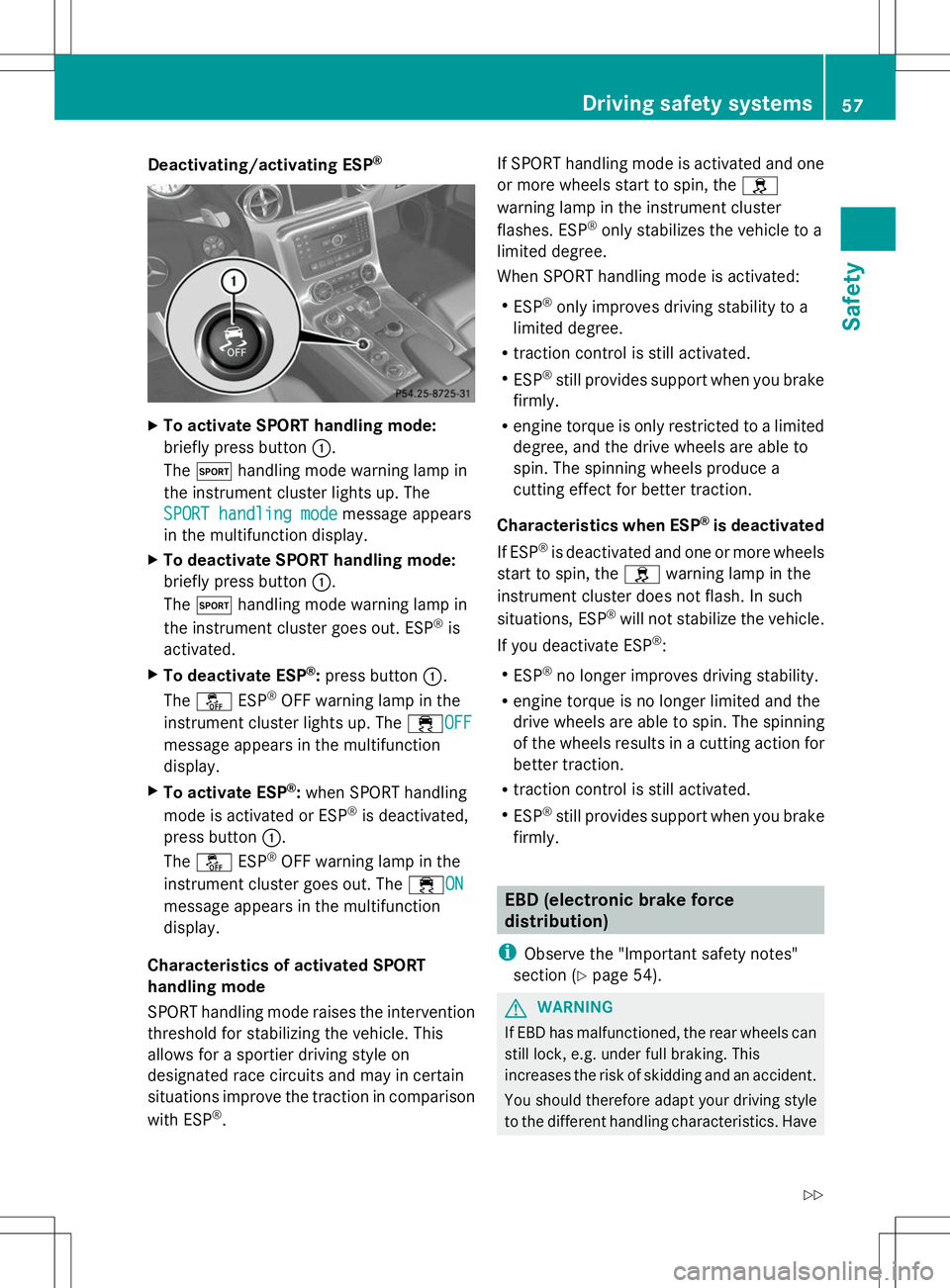
Deactivating/activating ESP
®X
To activate SPORT handling mode:
briefly press button :.
The M handling mode warning lamp in
the instrument cluster lights up. The
SPORT handling mode
SPORT handling mode message appears
in the multifunction display.
X To deactivate SPORT handling mode:
briefly press button :.
The M handling mode warning lamp in
the instrument cluster goes out. ESP ®
is
activated.
X To deactivate ESP ®
:press button :.
The å ESP®
OFF warning lamp in the
instrument cluster lights up. The ÷OFFOFF
message appears in the multifunction
display.
X To activate ESP ®
:when SPORT handling
mode is activated or ESP ®
is deactivated,
press button :.
The å ESP®
OFF warning lamp in the
instrument cluster goes out. The ÷ONON
message appears in the multifunction
display.
Characteristics of activated SPORT
handling mode
SPORT handling mode raises the intervention
threshold for stabilizing the vehicle. This
allows for a sportier driving style on
designated race circuits and may in certain
situations improve the traction in comparison
with ESP ®
. If SPORT handling mode is activated and one
or more wheels start to spin, the
h
warning lamp in the instrument cluster
flashes. ESP ®
only stabilizes the vehicle to a
limited degree.
When SPORT handling mode is activated:
R ESP ®
only improves driving stability to a
limited degree.
R traction control is still activated.
R ESP ®
still provides support when you brake
firmly.
R engine torque is only restricted to a limited
degree, and the drive wheels are able to
spin. The spinning wheels produce a
cutting effect for better traction.
Characteristics when ESP ®
is deactivated
If ESP ®
is deactivated and one or more wheels
start to spin, the hwarning lamp in the
instrument cluster does not flash. In such
situations, ESP ®
will not stabilize the vehicle.
If you deactivate ESP ®
:
R ESP ®
no longer improves driving stability.
R engine torque is no longer limited and the
drive wheels are able to spin. The spinning
of the wheels results in a cutting action for
better traction.
R traction control is still activated.
R ESP ®
still provides support when you brake
firmly. EBD (electronic brake force
distribution)
i Observe the "Important safety notes"
section (Y page 54). G
WARNING
If EBD has malfunctioned, the rear wheels can
still lock, e.g. under full braking. This
increases the risk of skidding and an accident.
You should therefore adapt your driving style
to the different handling characteristics. Have Driving safety syste
ms
57Safety
Z
Page 140 of 292
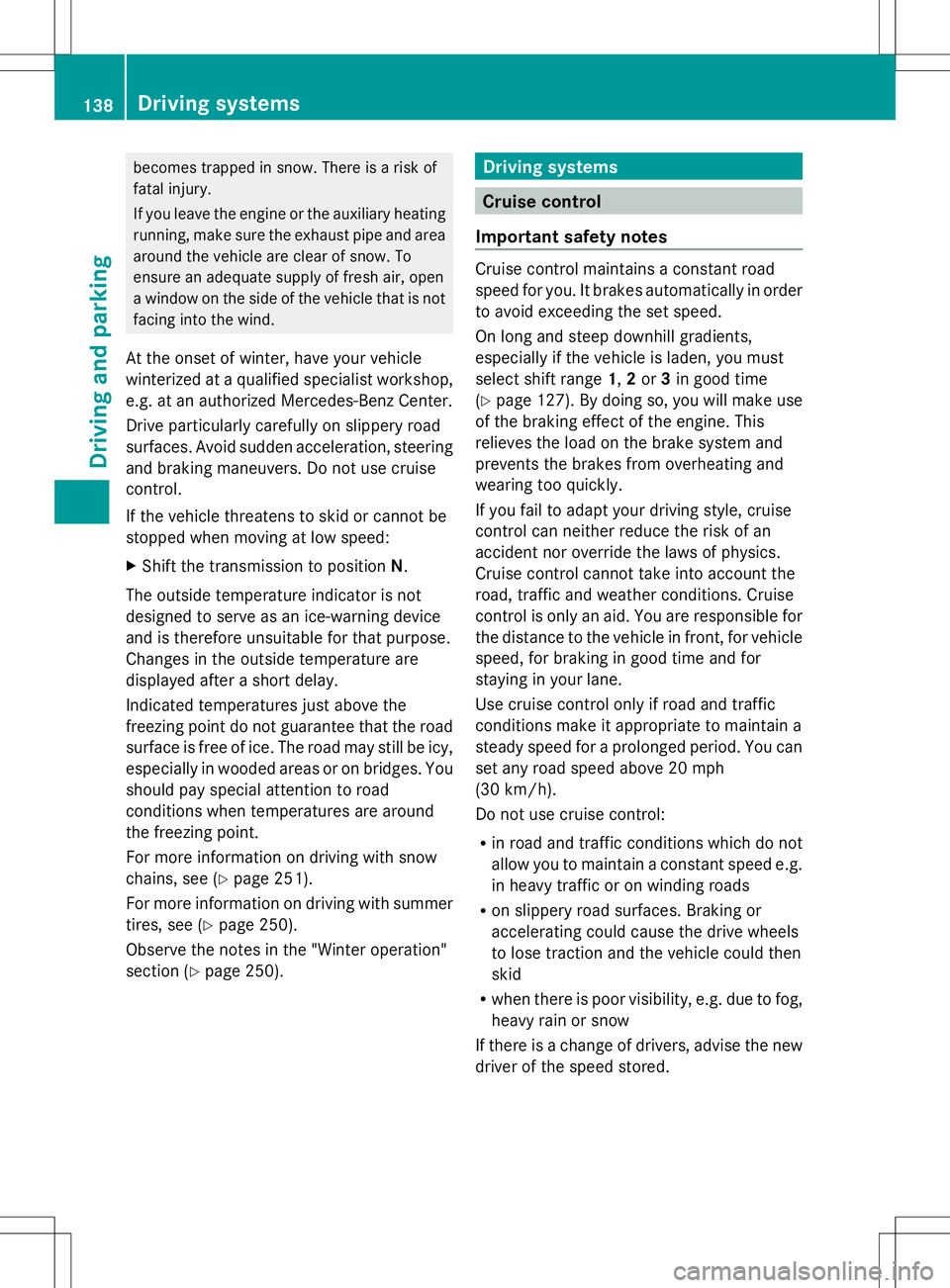
becomes trapped in snow. There is a risk of
fatal injury.
If you leave the engine or the auxiliary heating
running, make sure the exhaust pipe and area
around the vehicle are clear of snow. To
ensure an adequate supply of fresh air, open
a window on the side of the vehicle that is not
facing into the wind.
At the onset of winter, have your vehicle
winterized at a qualified specialist workshop,
e.g. at an authorized Mercedes-Benz Center.
Drive particularly carefully on slippery road
surfaces. Avoid sudden acceleration, steering
and braking maneuvers. Do not use cruise
control.
If the vehicle threatens to skid or cannot be
stopped when moving at low speed:
X Shift the transmission to position N.
The outside temperature indicator is not
designed to serve as an ice-warning device
and is therefore unsuitable for that purpose.
Changes in the outside temperature are
displayed after a short delay.
Indicated temperatures just above the
freezing point do not guarantee that the road
surface is free of ice. The road may still be icy,
especially in wooded areas or on bridges. You
should pay special attention to road
conditions when temperatures are around
the freezing point.
For more information on driving with snow
chains, see (Y page 251).
For more information on driving with summer
tires, see (Y page 250).
Observe the notes in the "Winter operation"
section (Y page 250). Driving systems
Cruise control
Important safety notes Cruise control maintains a constant road
speed for you. It brakes automatically in order
to avoid exceeding the set speed.
On long and steep downhill gradients,
especially if the vehicle is laden, you must
select shift range
1,2or 3in good time
(Y page 127). By doing so, you will make use
of the braking effect of the engine. This
relieves the load on the brake system and
prevents the brakes from overheating and
wearing too quickly.
If you fail to adapt your driving style, cruise
control can neither reduce the risk of an
accident nor override the laws of physics.
Cruise control cannot take into account the
road, traffic and weather conditions. Cruise
control is only an aid. You are responsible for
the distance to the vehicle in front, for vehicle
speed, for braking in good time and for
staying in your lane.
Use cruise control only if road and traffic
conditions make it appropriate to maintain a
steady speed for a prolonged period. You can
set any road speed above 20 mph
(30 km/h).
Do not use cruise control:
R in road and traffic conditions which do not
allow you to maintain a constant speed e.g.
in heavy traffic or on winding roads
R on slippery road surfaces. Braking or
accelerating could cause the drive wheels
to lose traction and the vehicle could then
skid
R when there is poor visibility, e.g. due to fog,
heavy rain or snow
If there is a change of drivers, advise the new
driver of the speed stored. 138
Driving systemsDriving and parking
Page 191 of 292
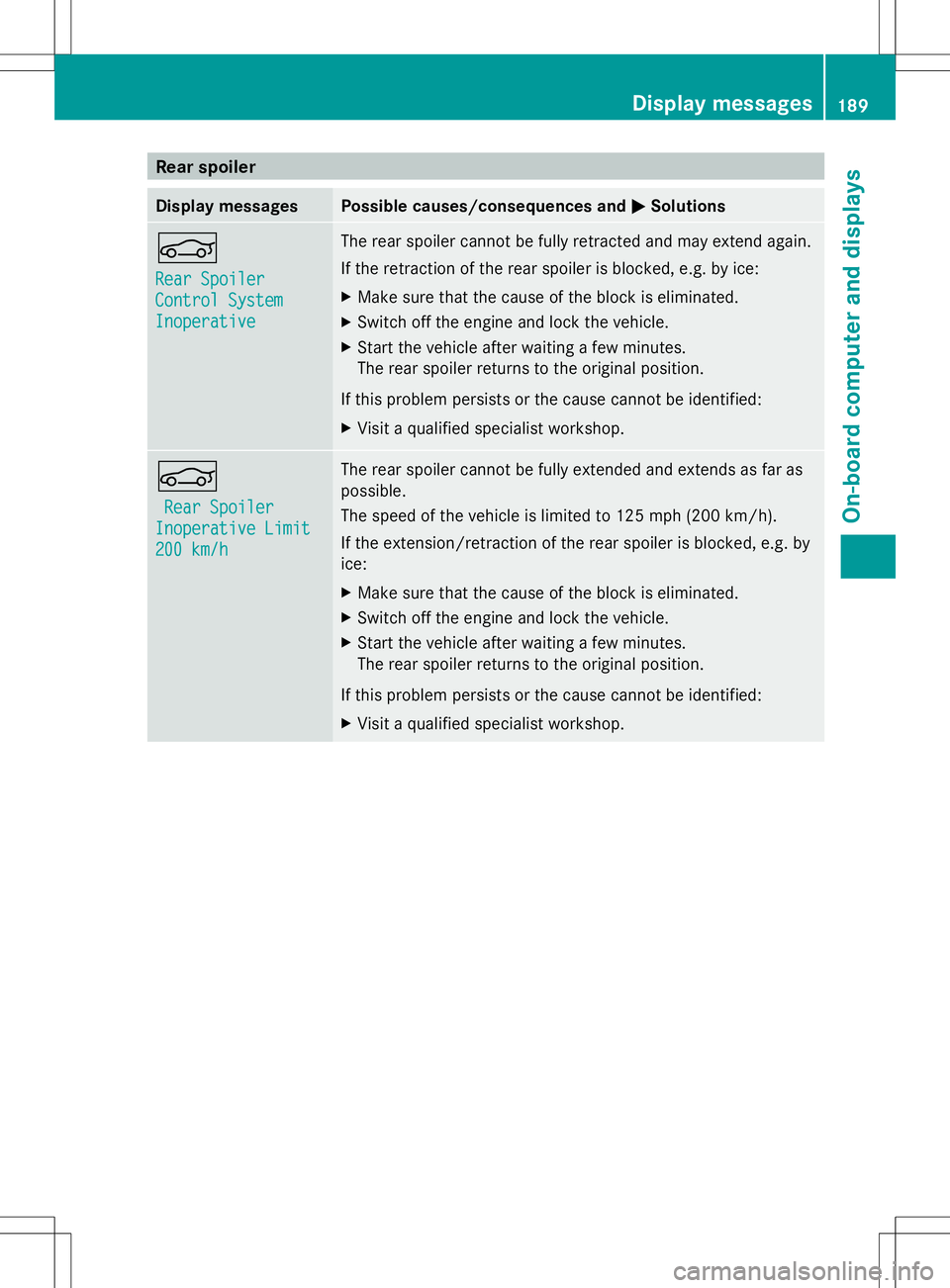
Rear spoiler
Display messages Possible causes/consequences and
M
MSolutions Ñ
Rear Spoiler Rear Spoiler
Control System Control System
Inoperative Inoperative The rear spoiler cannot be fully retracted and may extend again.
If the retraction of the rear spoiler is blocked, e.g. by ice:
X
Make sure that the cause of the block is eliminated.
X Switch off the engine and lock the vehicle.
X Start the vehicle after waiting a few minutes.
The rear spoiler returns to the original position.
If this problem persists or the cause cannot be identified:
X Visit a qualified specialist workshop. Ñ
Rear Spoiler Rear Spoiler
Inoperative Limit
Inoperative Limit
200 km/h 200 km/h The rear spoiler cannot be fully extended and extends as far as
possible.
The speed of the vehicle is limited to 125 mph (200 km/h).
If the extension/retraction of the rear spoiler is blocked, e.g. by
ice:
X
Make sure that the cause of the block is eliminated.
X Switch off the engine and lock the vehicle.
X Start the vehicle after waiting a few minutes.
The rear spoiler returns to the original position.
If this problem persists or the cause cannot be identified:
X Visit a qualified specialist workshop. Display messages
189On-board computer and displays Z
Page 195 of 292
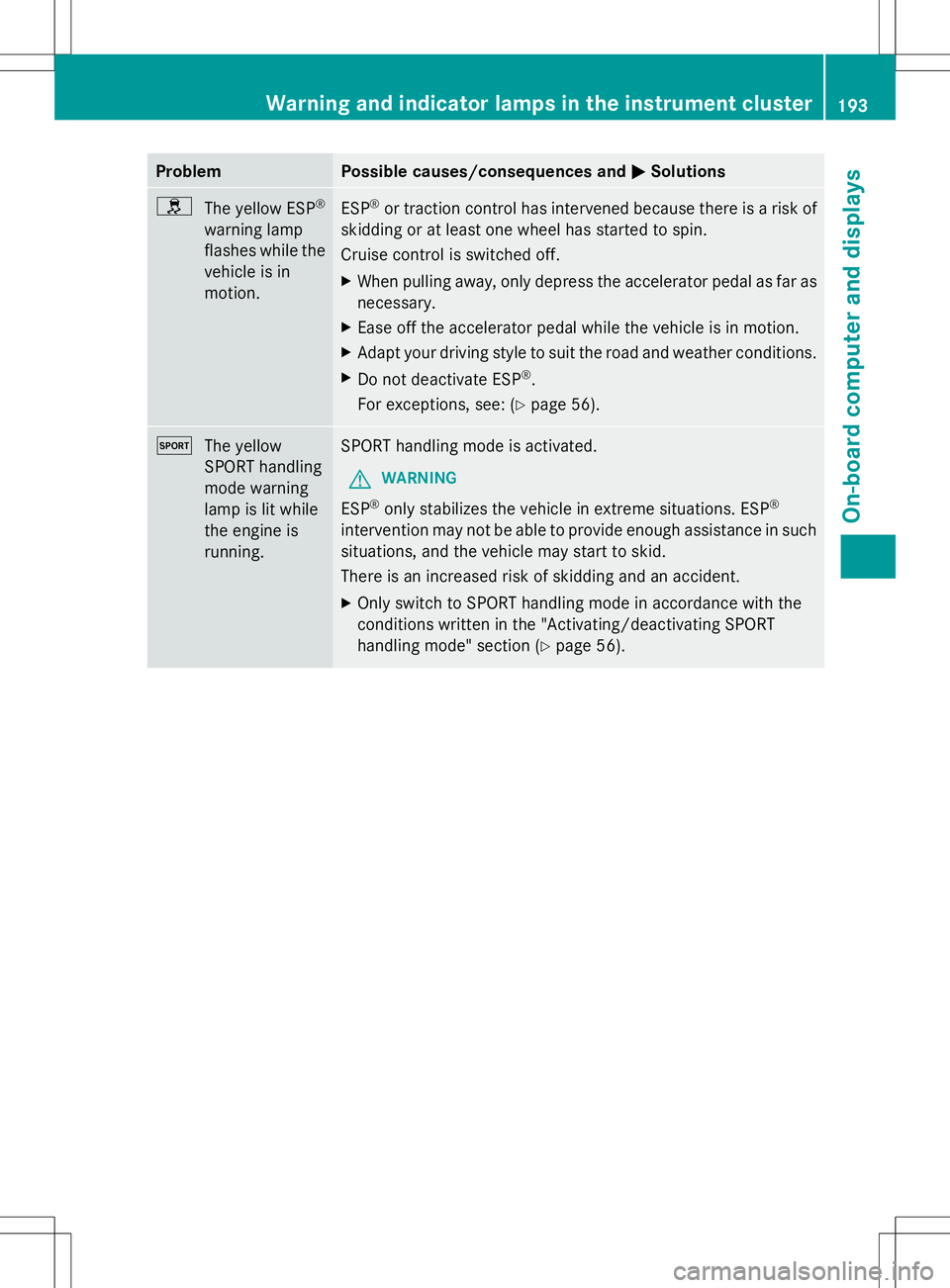
Problem Possible causes/consequences and
M
MSolutions h
The yellow ESP ®
warning lamp
flashes while the
vehicle is in
motion. ESP
®
or traction control has intervened because there is a risk of
skidding or at least one wheel has started to spin.
Cruise control is switched off.
X When pulling away, only depress the accelerator pedal as far as
necessary.
X Ease off the accelerator pedal while the vehicle is in motion.
X Adapt your driving style to suit the road and weather conditions.
X Do not deactivate ESP ®
.
For exceptions, see: (Y page 56).M
The yellow
SPORT handling
mode warning
lamp is lit while
the engine is
running. SPORT handling mode is activated.
G WARNING
ESP ®
only stabilizes the vehicle in extreme situations. ESP ®
intervention may not be able to provide enough assistance in such
situations, and the vehicle may start to skid.
There is an increased risk of skidding and an accident.
X Only switch to SPORT handling mode in accordance with the
conditions written in the "Activating/deactivating SPORT
handling mode" section (Y page 56). Warning and indicator lamps in the instrument cluster
193On-board computer and displays Z
Page 251 of 292
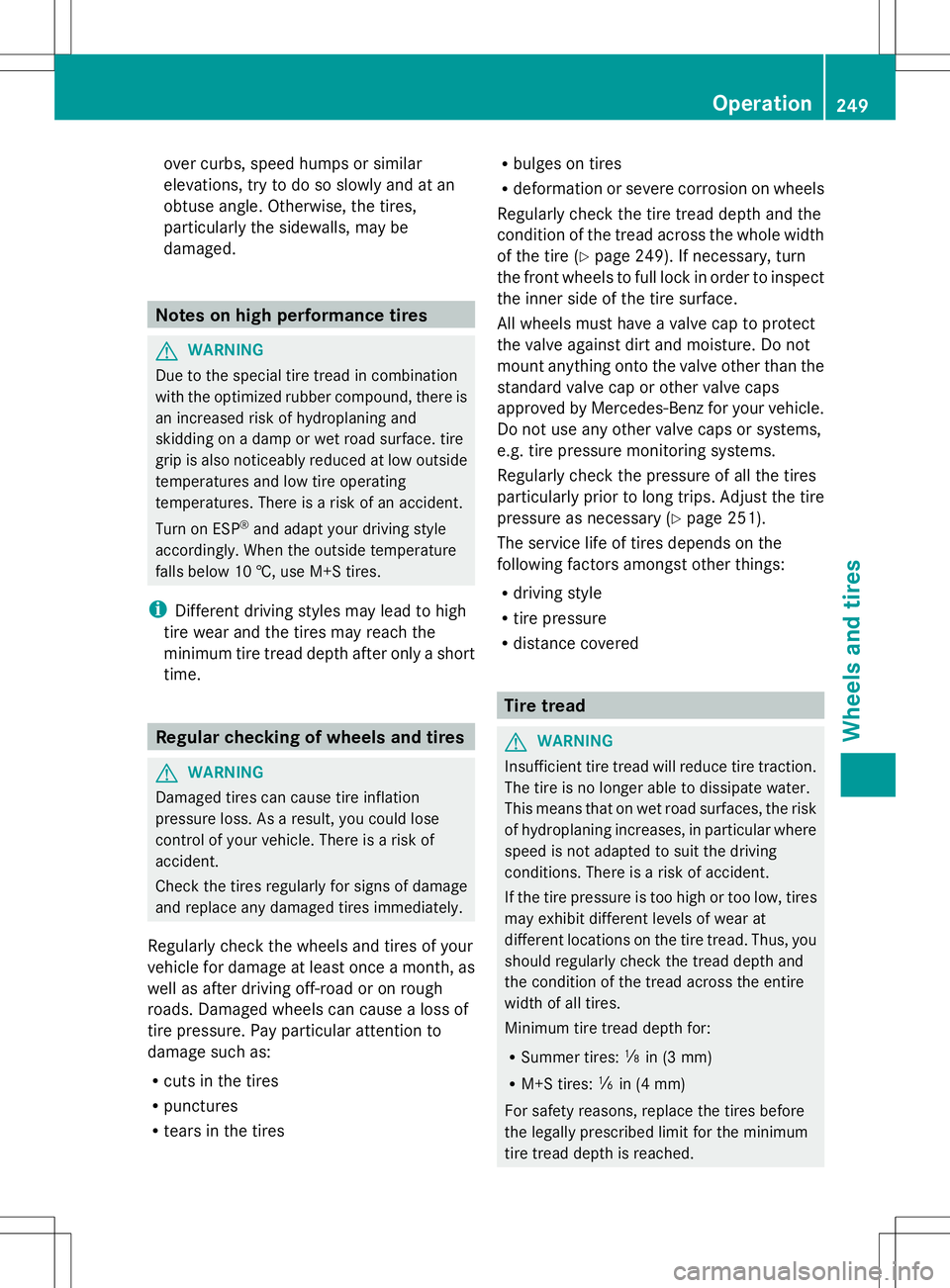
over curbs, speed humps or similar
elevations, try to do so slowly and at an
obtuse angle. Otherwise, the tires,
particularly the sidewalls, may be
damaged.
Notes on high performance tires
G
WARNING
Due to the special tire tread in combination
with the optimized rubber compound, there is
an increased risk of hydroplaning and
skidding on a damp or wet road surface. tire
grip is also noticeably reduced at low outside
temperatures and low tire operating
temperatures. There is a risk of an accident.
Turn on ESP ®
and adapt your driving style
accordingly. When the outside temperature
falls below 10 †, use M+S tires.
i Different driving styles may lead to high
tire wear and the tires may reach the
minimum tire tread depth after only a short
time. Regular checking of wheels and tires
G
WARNING
Damaged tires can cause tire inflation
pressure loss. As a result, you could lose
control of your vehicle. There is a risk of
accident.
Check the tires regularly for signs of damage
and replace any damaged tires immediately.
Regularly check the wheels and tires of your
vehicle for damage at least once a month, as
well as after driving off-road or on rough
roads. Damaged wheels can cause a loss of
tire pressure. Pay particular attention to
damage such as:
R cuts in the tires
R punctures
R tears in the tires R
bulges on tires
R deformation or severe corrosion on wheels
Regularly check the tire tread depth and the
condition of the tread across the whole width
of the tire (Y page 249). If necessary, turn
the front wheels to full lock in order to inspect
the inner side of the tire surface.
All wheels must have a valve cap to protect
the valve against dirt and moisture. Do not
mount anything onto the valve other than the
standard valve cap or other valve caps
approved by Mercedes-Benz for your vehicle.
Do not use any other valve caps or systems,
e.g. tire pressure monitoring systems.
Regularly check the pressure of all the tires
particularly prior to long trips. Adjust the tire
pressure as necessary (Y page 251).
The service life of tires depends on the
following factors amongst other things:
R driving style
R tire pressure
R distance covered Tire tread
G
WARNING
Insufficient tire tread will reduce tire traction.
The tire is no longer able to dissipate water.
This means that on wet road surfaces, the risk
of hydroplaning increases, in particular where
speed is not adapted to suit the driving
conditions. There is a risk of accident.
If the tire pressure is too high or too low, tires
may exhibit different levels of wear at
different locations on the tire tread. Thus, you
should regularly check the tread depth and
the condition of the tread across the entire
width of all tires.
Minimum tire tread depth for:
R Summer tires: âin (3 mm)
R M+S tires: ãin (4 mm)
For safety reasons, replace the tires before
the legally prescribed limit for the minimum
tire tread depth is reached. Operation
249Wheels and tires Z